Do you love movies? What about writing about them?
If you answered yes to both, then learning how to start a movie blog could be the perfect way for you to share your passion for movies and make money online.
In this post, I will show you how to start a movie blog and monetize it. We will walk you through everything you need to know to get started, from choosing a domain name and setting up your website, to writing movie reviews and monetizing your blog.
So let’s get started!

How to Start a Movie Blog in 7 Steps
- Define Your Movie Blogging Goals
- Choose a Movie Niche
- Pick & Register a Blog Domain Name
- Setup WordPress
- Write & Publish Blog Posts
- Promote Your Movie Blog
- Monetize & Make Money
1. Define Your Movie Blogging Goals
The first step to starting a movie blog is defining your goals.
Why do you want to start a movie blog?
- Do you want to be a movie critic?
- Do you want to share your movie recommendations with others?
- Do you want to make money online talking about movies?
Once you have defined your goals, it will be easier for you to create a plan for how to achieve them.
What is a Movie Blog?
A movie blog is simply a blog about movies and will include movie reviews, lists & recommendations along with news and insights. Some movie blogs are focused on actors and directors.
Why Start a Movie Blog?
There are many reasons to start a movie blog. The main benefits of starting a movie blog include:
- Sharing your love of movies with others.
- Building an online community around movies.
- Becoming a recognized expert in the movie industry.
- Making money online through advertising, affiliate marketing, or other monetization strategies.
How much money can you make from movie blogging?
You can make $15-$25 for every 1000 ad views on your movie blog. An SEO optimized blog post can get anywhere between 300 to 1000 visits per month. So, a movie blog with 100 blog posts can make as high as $2500 every month. You can make even more money if you monetize with affiliate marketing and digital products.
2. Choose a Movie Niche
Now that you have defined your goals, it’s time to choose a movie niche.
Your niche is the specific topic that your blog will focus on.
For example, if you want to start a movie blog, your niche could be “action movies” or “indie films.” Your movie
Why choose a niche?
There are three main reasons to choose a niche for your movie blog:
- It will be easier to build an audience if you focus on a specific topic.
- You will be able to establish yourself as an expert in your chosen niche.
- It will be easier to monetize your blog if you have a specific target audience.
Finding Your Ideal Niche
There are a few questions you can ask yourself to help you find your movie niche:
- What are your favorite movies?
- What kind of movies do you know the most about?
- What kind of movies do you want to learn more about?
- What are your movie blogging goals?
Here are a few movie niches to help you find yours:
- Movie Genres
- Generalized Movie Blog
- Asian or Foreign Films
- Netflix Movies
- Retro Movies
- Hollywood Movies
- Movies by Languages
- Animation Movies
Examples of Movie Blog
Sometimes looking at other movie blogs will help inspire ideas of your own. Here are some of the more popular examples of movie blogs:
[auto-list-number] Screen Rant
This is a general movie and TV show blog. It covers a wide range of topics, from movie and TV news to reviews and opinion pieces. We won’t recommend creating a general movie blog like Screen Rant because you will need a huge team of writers to be able to compete.

[auto-list-number] Roger Ebert
Roger Ebert was a famous movie critic who had his own movie blog. He focused on movie reviews and criticism. If you want to start a blog like Roger Ebert, then your focus should be on writing compelling reviews that engage your readers.
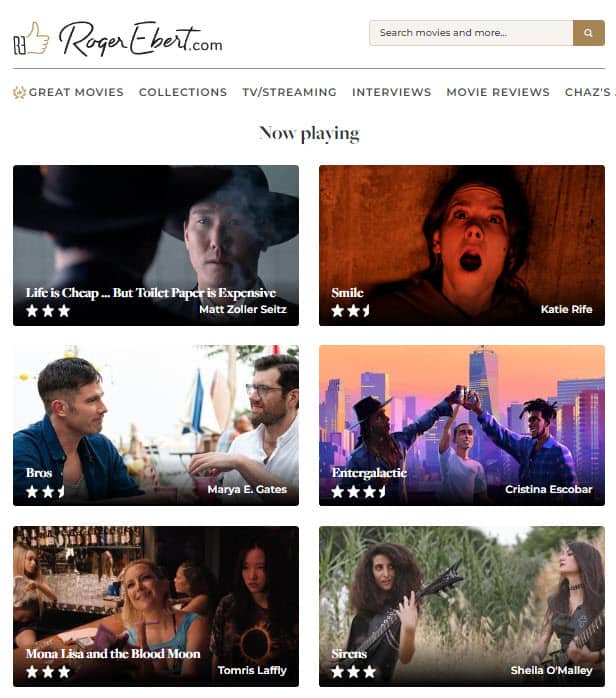
[auto-list-number] ComingSoon.net
ComingSoon.net is a movie news blog that covers the latest Hollywood movies, as well as independent films and foreign films. If you want to write about the latest movies in your movie niche, then building a movie news blog like ComingSoon.net may be a good option for you.

[auto-list-number] JoBlo
JoBlo.com is a movie blog that consolidates all the latest movies, trailers, posters, and interviews all in one place. If you want to focus on hardcore movie analysis and criticism, then building a blog like JoBlo.com may be the right choice for you.
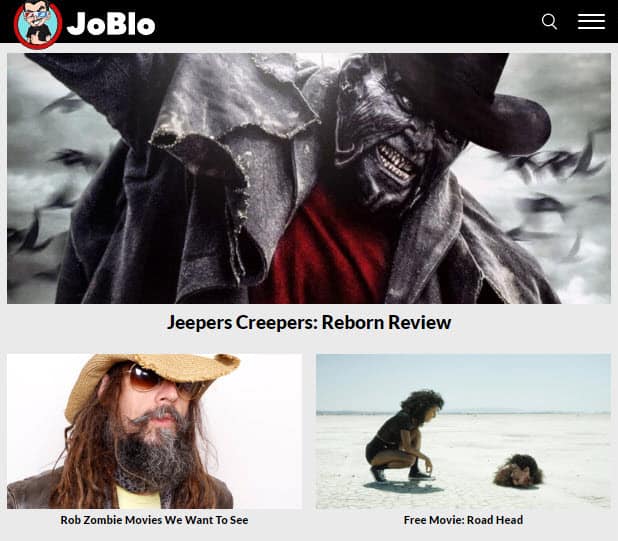
[auto-list-number] The Hollywood Reporter
The Hollywood Reporter covers the business side of the movie industry. If you want to focus on the business and marketing side of movies, then starting a blog like The Hollywood Reporter may be a good option for you.

Now that you have some ideas for your movie niche, it’s time to choose one and get started!
3. Pick & Register a Blog Domain Name
Once you have chosen your niche, it is time to brainstorm a few names for your movie blog.
We recommend you keep your movie blog’s name to two words (Example: Screen Rant). One of the two words should be a keyword from your niche. The other word can be something that makes your website brandable. For example, our blog teaches people how to make passive income, so we have named it Passive Book.
Here are some of the words that you can mix and match into your blog name:
- Movies
- Film
- Screen
- Hollywood
- Cinema
- Popcorn
- Theater
- Trailer
- Show
- Flicks
Use a Business Name Generator to brainstorm the name of your blog.
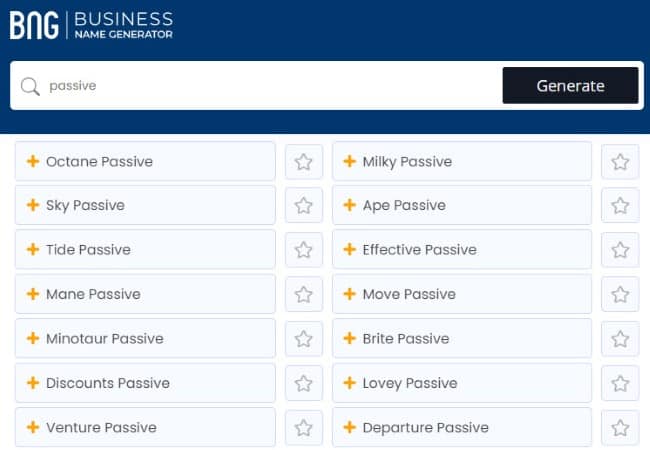
You can also use your own name for your blog. But if you ever plan to sell your website in the future, it is much more difficult to transfer your brand to the buyer when it is your name.
Check Domain Name Availability
After you have brainstormed a few names for your movie blog, you should check if the .com domain name is available.
A blog’s domain name is the web address for that blog. It is how people will find your blog online. It is typically your blog’s name followed by .com.
You must check if both the .com domain name and the social media handles are available. You can use Namechk to check the availability of both your domain name and social media handles.
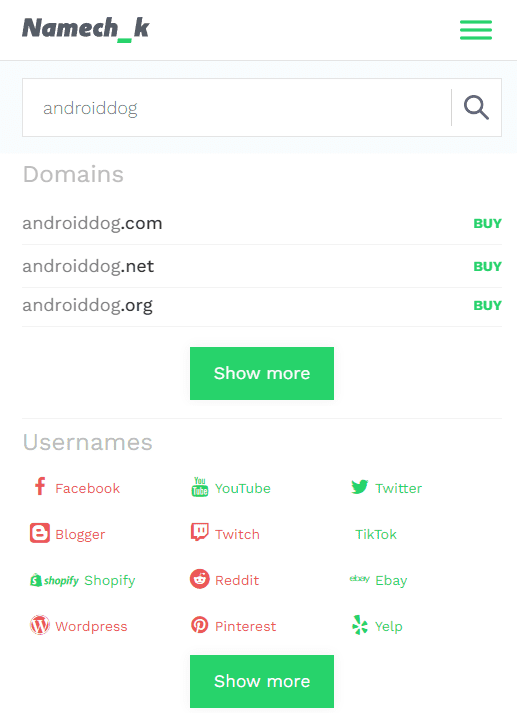
Here are a few things to keep in mind when selecting a domain name:
- Choose a .com domain name. 86% of the internet uses .com, so your visitors are likely to try visiting your blog by typing .com. Avoid other extensions like .net or .org.
- Don’t include hyphens and numbers.
- Do not use words with multiple spellings (for example colour vs color).
- Shorter domain names are better. Try to keep it under 12 characters.
- Spelling & Pronunciation should be easy and intuitive.
- It should be easy to remember.
- Avoid words that can be misread together. For example, therapistjohn.com can be read as Therapist John or The Rapist John.
- Make sure it’s not trademarked or copyrighted by someone else. The AI writing software Jarvis.ai had to rebrand to Jasper.ai because Marvel sued them for the Iron Man reference. Lawsuits will happen once your blog is established.
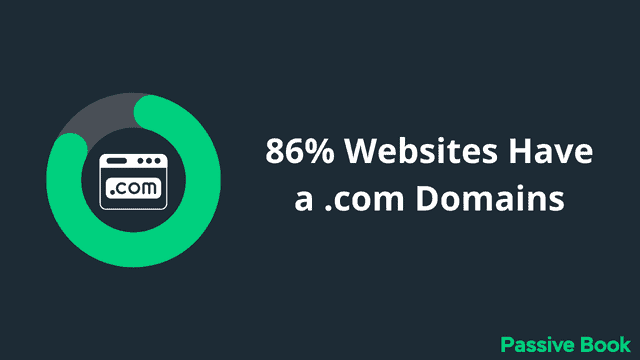
Register a Domain Name
Once you decide your domain name it is time to register it.
You should register your domain with NameCheap because you will get domain privacy for free. Other providers charge $12 per year for domain privacy. Without domain privacy, your name, home & email address will be accessible to the public.
Step 1: Go to NameCheap. Enter your domain name with the .com extension.
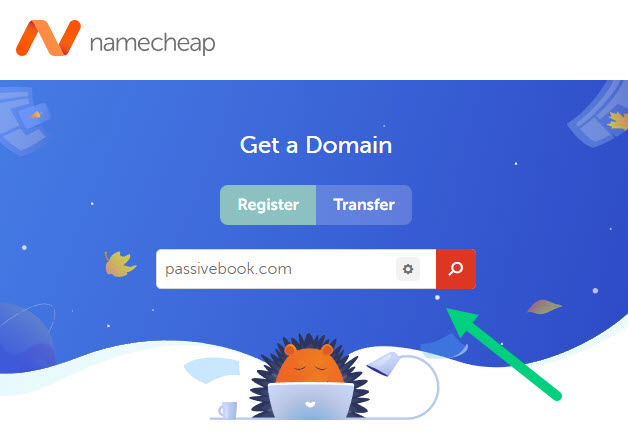
Step 2: Select the .com extension and click the Add to Cart button.
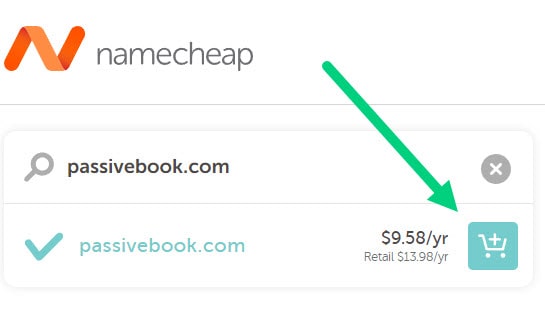
Step 3: After adding the domain to the cart, click on the Checkout button.
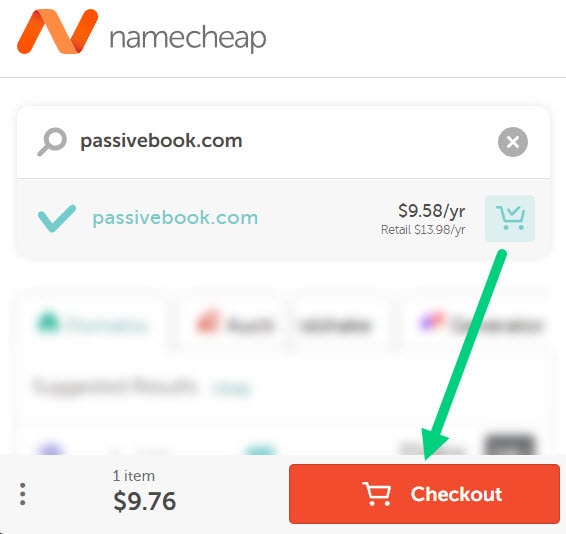
Step 4: Enable Domain Privacy that comes for free along with auto-renew. You don’t need any other paid addon.
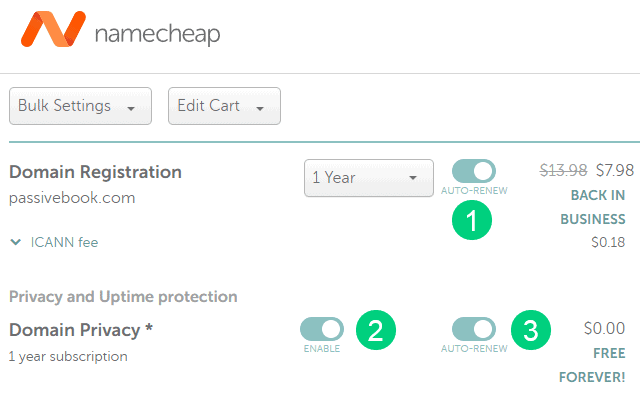
Step 5: Click on Confirm Order. Pay to complete your purchase.

Step 6: Log in to Namecheap and click on Domain List ❶ in the left sidebar and then click Manage ❷ next to the domain you just purchased.
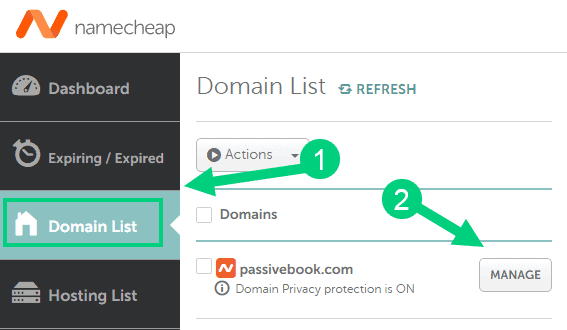
Step 7: Under the Nameservers section, select “Custom DNS” from the dropdown ❶. Then enter the following two nameservers ❷ ns1.bluehost.com and ns2.bluehost.com as shown in the image. Then click the green tick ❸ to save. If you use a hosting provider other than Bluehost, enter their nameserver values in this step instead.
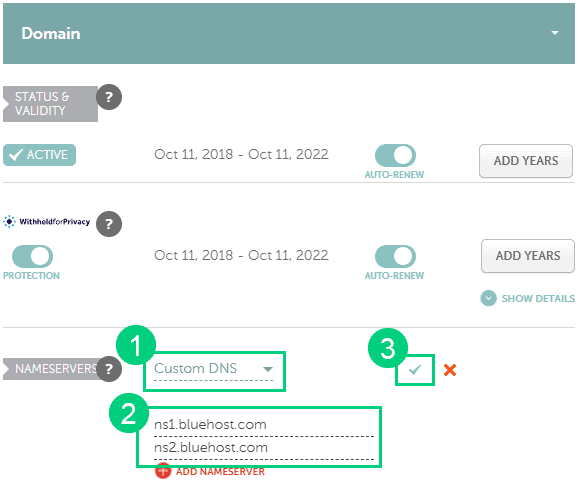
Can I get a free domain name?
Your web hosting provider might give you a free domain name for one year but they charge $12 for domain privacy which is free in Namecheap. From the second year, you will pay for both the domain and privacy which will cost you more than $20+. So it is cheaper to just register your domain with Namecheap from the beginning. Also using different companies for web hosting and domain registration will allow you to easily switch your blog host later without transferring domains.
Can I change the name of my blog later?
You will lose your search engine rankings if you change your blog’s name once it gets links from other websites. It will take as long as a year or more for you to regain the lost traffic. It is possible to mitigate problems by having proper redirects. But you will have to renew both your old and new domains every year. So try to avoid changing your blog’s name once it is established.
4. Setup WordPress
The next step is to get your blog up and running in WordPress.
WordPress is a blogging software that will power your blog. It makes blogging easy without learning how to code.
Why Choose WordPress.org?
There are many blogging platforms but the self-hosted wordpress.org powers 70% of blogs on the internet. 42% of all websites on the internet use WordPress.

Some of the benefits of using WordPress are:
- User-friendly interface that makes it easy to create and manage pages, posts, and categories.
- A wide variety of free and premium themes to customize how your blog looks.
- Thousands of plugins that let you add new features or enhance existing ones on your website.
- Ability to monetize your blog the way you want.
WordPress.org vs WordPress.com
There are two versions of WordPress.
WordPress.org is the self-hosted version where you need to buy hosting and a domain name. But it gives you full control over your blog and how you want to monetize it.
WordPress.com is the free version that runs on the wordpress.com subdomain with limited features and less control over how you monetize your blog.
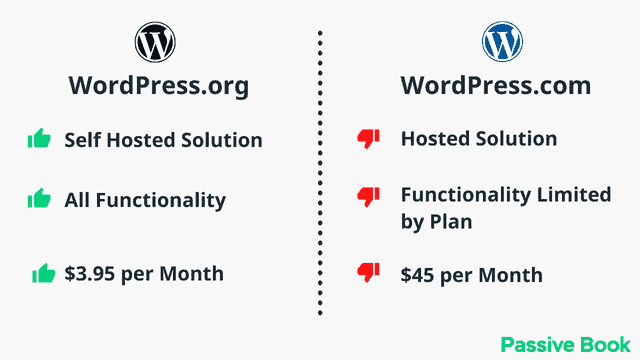
If you want to not only make your blog but also make money online, I would highly recommend you follow this guide and choose WordPress.org as it gives you more flexibility and control over how your blog is run.
Why Avoid Free Blogging Platforms
While free platforms like Blogger or Tumblr might seem tempting, they come with a lot of restrictions.
Some of the disadvantages of using free blogging platforms are:
- Difficult to drive traffic because they are not SEO friendly and are not favored by search engines like Google.
- Limited customization options for how your blog looks and how you can monetize it.
- Your content will be owned by the platform.
- You could lose all your hard work if the platform decides to shut down or change its policies.

How much does it cost to start a movie blog?
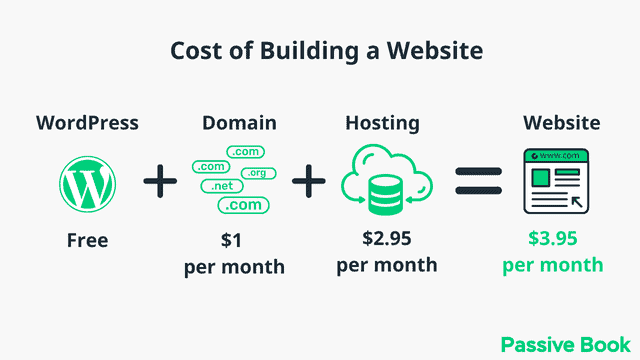
It will cost you $2.95 per month to host your WordPress movie blog in Bluehost. A domain will cost you $12/year. So that is a total of $4.2 per month, which is less than the price of Netflix for all the unlimited features that a self-hosted WordPress blog has to offer.
What to do if you already have a free blog?
Migrating from a free blogging platform to WordPress can be easy using an import plugin. The plugin will automatically transfer all your posts, comments, and images over to your new blog.
Install WordPress in Hosting
Now that you know why WordPress is the best blogging platform and how it compares to other blogging platforms, let’s look at how to set up WordPress for your blog.
You need web hosting to install WordPress. The web hosting will store your blog posts, images, and other files and load them into your visitor’s browsers when they visit your blog.
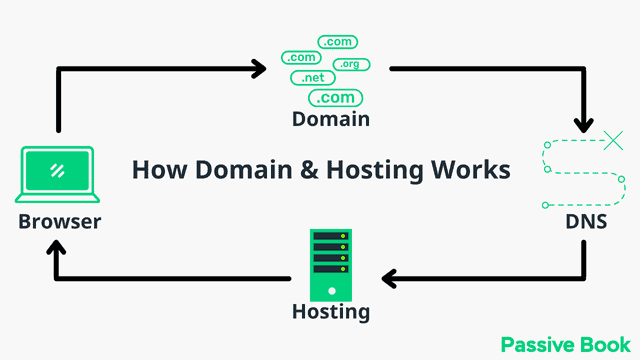
For this guide, we will use BlueHost as our web host. It is a cheap hosting that is extremely easy for beginners to set up. If you use any other web host, the steps will be the same but the user interface may be slightly different.
1. Go to BlueHost using this link to get a special discount. Select WordPress > WordPress Hosting from the top menu.
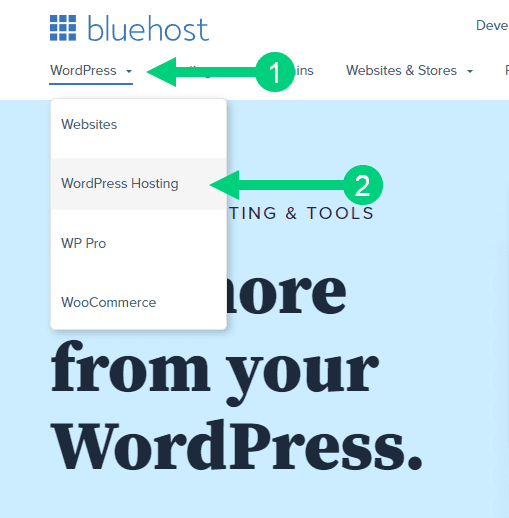
2. Click on the button you see on this page and you will be taken to the pricing section.
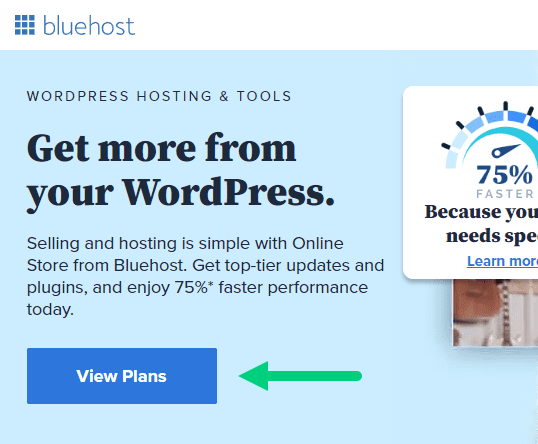
3. Select the Basic Plan. You can upgrade to a different hosting plan as you grow.

4. If you already have a domain name that you purchased with Namecheap you can put that in the “Use a domain you own” ❶ section. If you don’t have a domain name yet, choose the “Create a New Domain” ❷ to purchase a new domain.
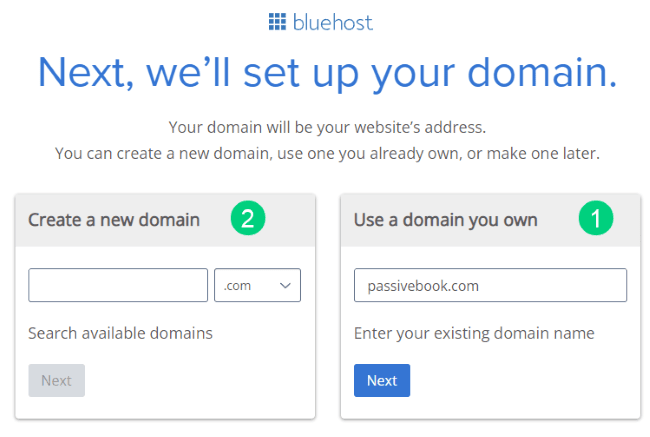
5. In the next screen, enter your information. Uncheck all package extras. If you purchase your domain through Bluehost instead of Namecheap, you may want to enable Domain Privacy. You won’t see the Domain Privacy option if you bought your domain through Namecheap. Namecheap will give you this Domain Privacy for free.
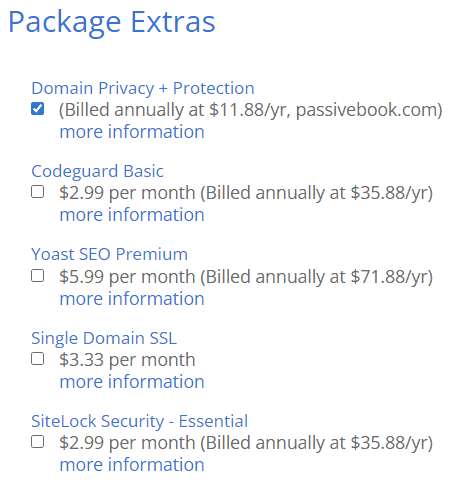
6. Once you have successfully paid, you will be prompted to set a password. Click on the “Create your Password” button.
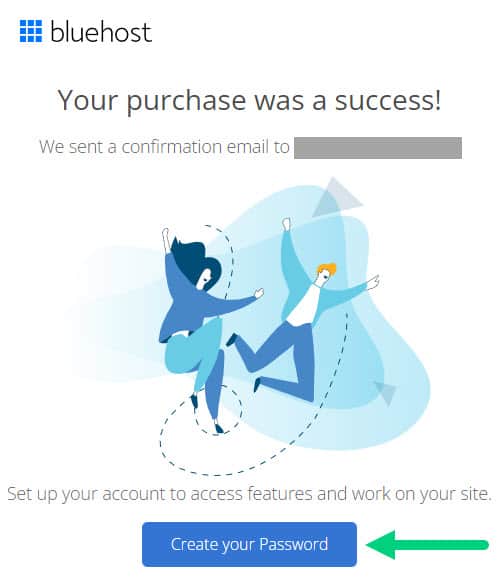
7. Enter your password and create your account. If you lose this password, you can reset it.
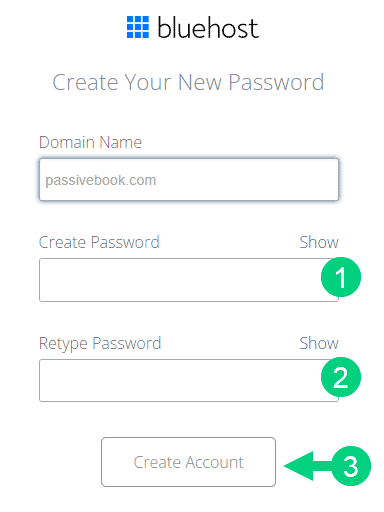
8. After you set your password, log in to Bluehost.
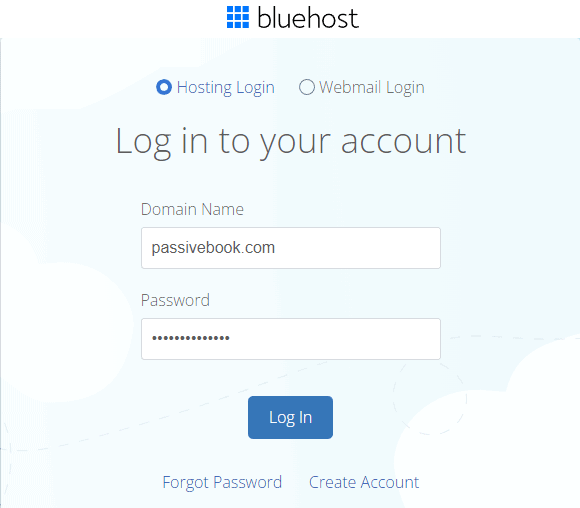
9. Click on the Create your website button on the following screen. This will start a Bluehost Wizard, just click Skip this step wherever possible.

10. On the following page, click “No help needed” or “Skip this step”. We don’t want Bluehost to limit our customization options.
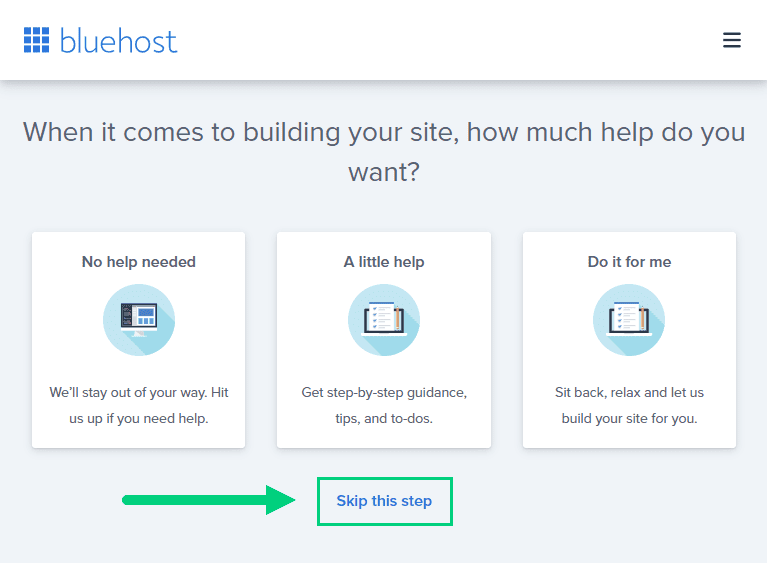
11. On the next page, you will be asked about the purpose of your website. You can choose from any of the available options.
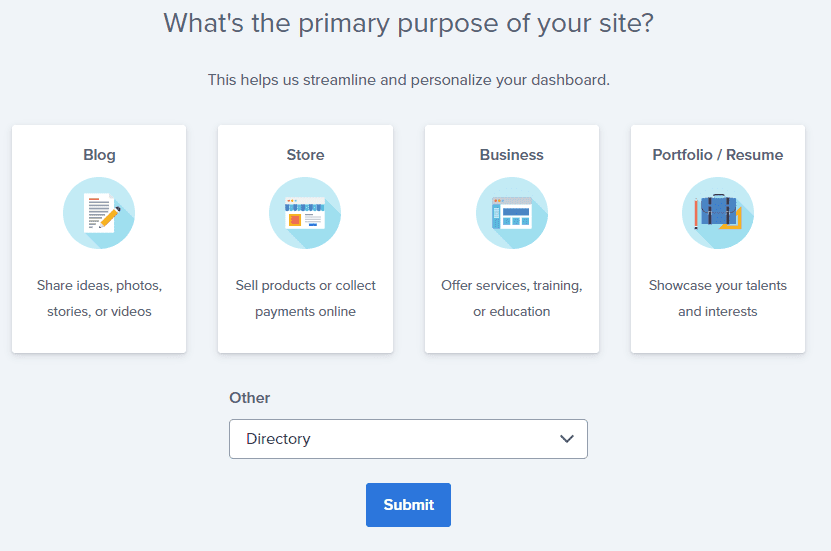
12. On the next page, click Skip this step.
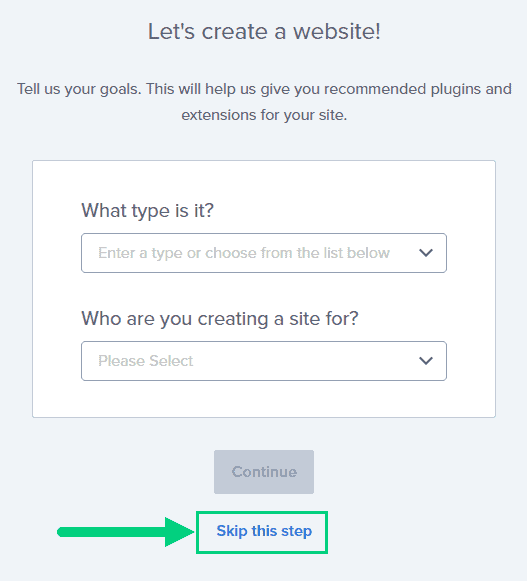
13. On the following page, enter the blog’s name and tagline. You can change this later so feel free to click “Skip this step” or enter something as a placeholder and click Continue.
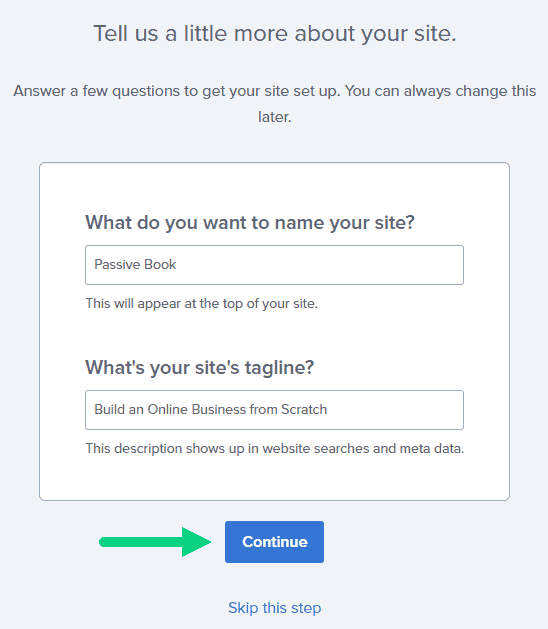
14. Finally you will be asked how you want to build your website. Choose “Limitless customization” to have all the options.

15. You can see your blog by going to yourdomain.com. Go to the Bluehost dashboard and click on the My Sites tab ❶ in the left sidebar and click on the “Manage site” button ❷.
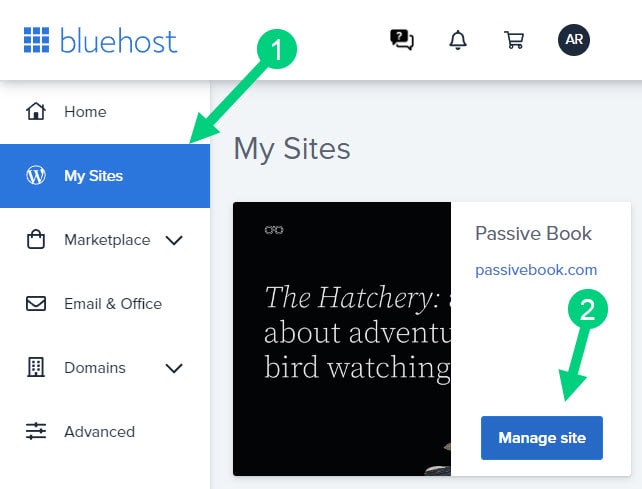
16. Your WordPress site has separate login credentials different from the ones you use to log into Bluehost. You can use this to log in to the WordPress dashboard directly without logging into Bluehost. To get this:
❶ Click on Users on top.
❷ You will be able to see your username and email that you can use to log in to WordPress.
❸ If you click on the three dots you will see the option to Reset your password. ❹
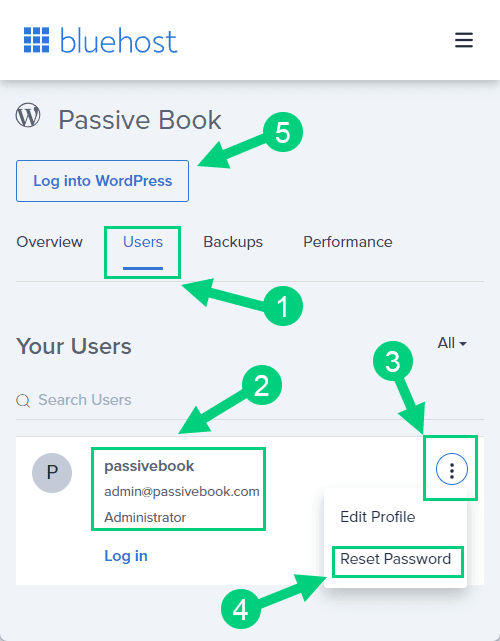
You can log into WordPress from the Bluehost dashboard by clicking the Log in to WordPress button ❺. But it is not recommended you rely on this as your primary login method because you will get locked out of your site if you ever change hosting providers.
17. You will be taken to the WordPress dashboard where you can reset your password ❶. If you don’t like the username Bluehost created for you, you can Add a New User ❷.

18. If you are adding a new user make sure you specify the user role as Administrator ❶. You can log in as the new user and safely delete the default user created by Bluehost.
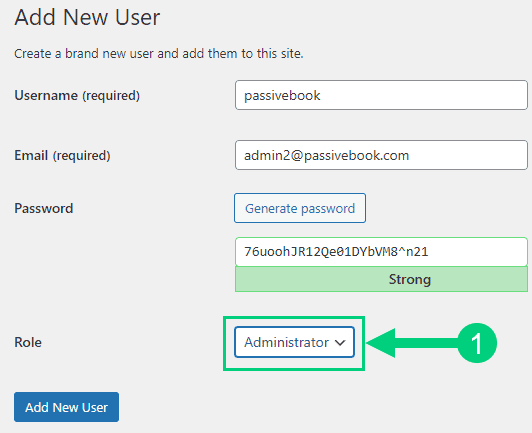
Congratulations! You have successfully set up WordPress.
Configure WordPress
Now that you have the basic version of WordPress installed, it is time to customize it to make it look and feel the way you want.
Login to WordPress Dashboard
The WordPress Dashboard is the control center for your blog. It is where you will manage all your posts, pages, comments, and settings. You can access it by visiting yourdomain.com/wp-admin.
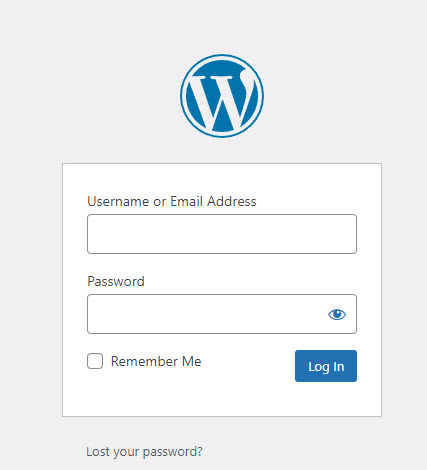
Use the Email and Password you provided during installation to log in to your WordPress dashboard. If you don’t have a password, use the “Lost your password?” to generate a new password.
Install WP Themes
A WordPress Theme is a customizable design for your website. It determines how your website looks and how your visitors interact with it.
Your new WordPress blog will be installed with a default blog theme that doesn’t look very great.
To install a new WordPress Theme:
Go to Appearance > Themes > Add New in your WordPress dashboard.
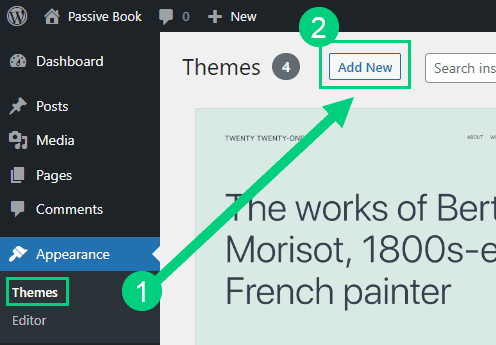
Use the search to find a theme that you like ❶. Before you install the theme, you can see a demo of the theme and learn about its features from the preview screen ❷. If you like the theme, you can install it by clicking the install button ❸. You can also upload a theme from a file on your computer ❹.
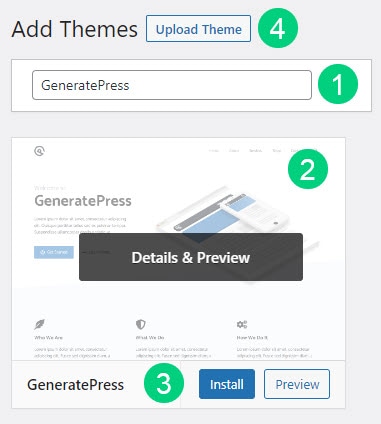
Once installed, click the Activate button to enable the theme.
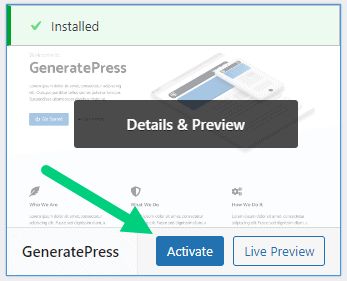
Although you can use a free theme (there are thousands of free themes available), we recommend using a premium theme.
Premium themes not only reduce your website’s load time but also help you customize your website to your heart’s desire.
Here are the premium themes we recommend:
There are also several custom-made movie blog themes. These themes tend to be bloated with poor code which will slow down the performance of your website. We suggest getting one of our recommended themes for a fast website with unlimited customization possibilities.
Install WP Plugins
A WordPress Plugin extends the functionality of WordPress. It can add new features to your website or it can improve the performance of your website.
There are over 50,000 WordPress plugins available for free on the official WordPress plugin repository.
Too many wordpress plugins can slow down your blog site. So before you install new plugins, it will be worth clearing out any existing plugins that your hosting provider installed by default.
Plugins first need to be deactivated before they can be deleted.
❶ Go to WP Admin > Plugins > Installed Plugins
❷ Click on the checkbox to select all plugins.
❸ Select Deactivate from the drop-down.
❹ Click Apply.
❺ Repeat the above steps but select “Delete” instead of “Deactivate” from the dropdown in ❸ to delete all the deactivated plugins.
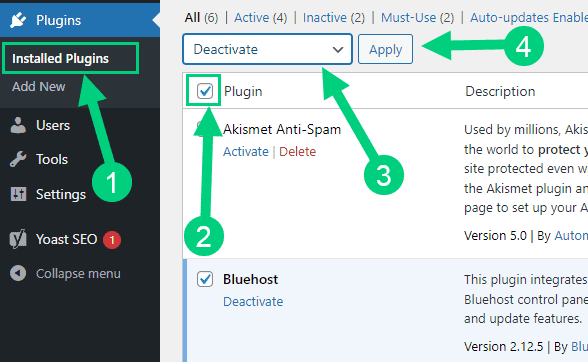
To install new plugins go to the WP Admin > Plugins > Add New.
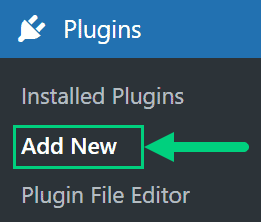
On the plugins page:
❶ Search for the plugin you want in the search bar
❷ Click Install Now. Once you install the plugin, you must also activate the plugin for it to be enabled.
❸ If you are installing a paid plugin you can upload the plugin instead.
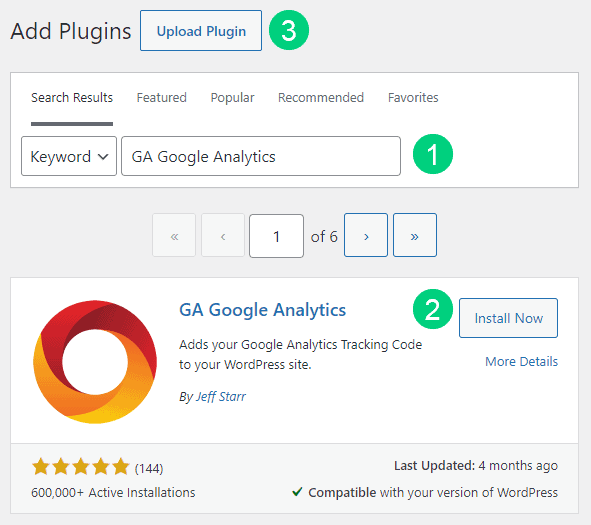
There are many different movie blog plugins that you can install, but here are the ones which we recommend:
Backup Plugin: A WordPress Backup Plugin helps you create backups of your website. This is important because it allows you to restore your website if something goes wrong.
Recommended Plugin: WPVivid (paid) or UpdraftPlus (free).
SEO Plugin: A WordPress SEO Plugin helps you improve the ranking of your website in search engines. It allows your website to be seen by more people.
Recommended Plugin: RankMath (paid).
Google Analytics Plugin: A WordPress Google Analytics Plugin is a software that helps you collect data about how people are using your website. It helps you to track your website’s traffic and improve the usability of your website.
Recommended Plugin: RankMath (paid) or GA Google Analytics (free).
Cache Plugin: Cache plugins help speed up your website by caching your website’s pages and posts. This means that the next time someone visits your website, the page will load faster because it doesn’t have to be generated from scratch.
Recommended Plugin: WP Rocket (paid).
Page Builder Plugin: A WordPress Page Builder Plugin is a software that helps you create custom pages for your website. You can create pages that look different from the default WordPress pages.
Recommended Plugin: Thrive Architect (paid).
Security Plugin: A WordPress Security Plugin helps you protect your website from hackers and malware. It does this by adding security features to your website such as two-factor authentication, malware scanning, and password protection.
Recommended Plugin: Wordfence (free).
Social Media Plugin: A WordPress Social Share Plugin is a software that allows you to share your website’s posts and pages on social media platforms such as Facebook, Twitter, and LinkedIn.
Recommended Plugin: Easy Social Share Buttons (paid).
Email List & Lead Generation Plugin: A WordPress Email Opt-in Form Plugin is a software that allows you to collect email addresses from people who visit your website. It allows you to build an email list of people who are interested in your content.
Recommended Plugin: Thrive Leads (paid).
Customize WordPress
Once you have installed your theme and plugins, it is time to customize the wordpress blog platform:
Change Colors, Fonts & Spacing
You can set the font, colors, and spacing by going to Appearance > Customize in your WordPress dashboard. Premium themes like GeneratePress allow you to customize every aspect of your blog.

Check out our Blog Fonts & Typography guide to choose the right font and typography settings for your blog.
Add Your Logo
Get a logo designed for your blog from Fiverr. Then set the logo of your blog by going to Appearance > Customize in your WordPress dashboard. A logo is not required for a successful blog but it can definitely help appeal to your target audience.
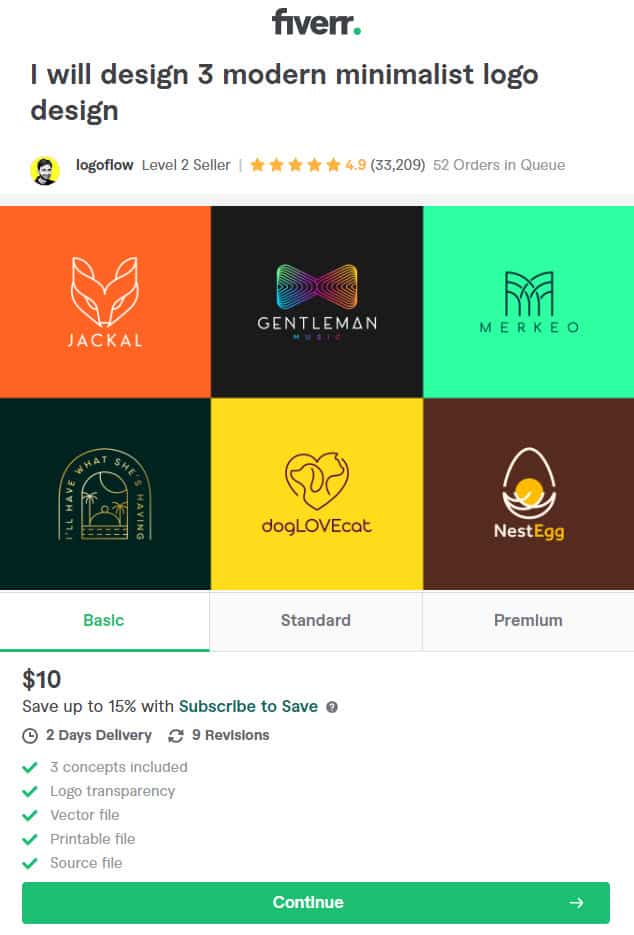
Change Favicon
Favicon is the image that appears in the browser tab and bookmarks. Set the Favicon from the Appearance > Customize section of the WordPress dashboard.

Create Menus
The header and the footer menu can be set from the Appearance > Menus in your WordPress blog dashboard.
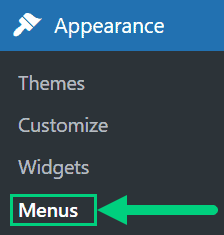
You can nest menu items so that it appears as a dropdown menu ❶. You can use the menu as your primary or secondary navigation menu ❷. Don’t forget to save your menu ❸.
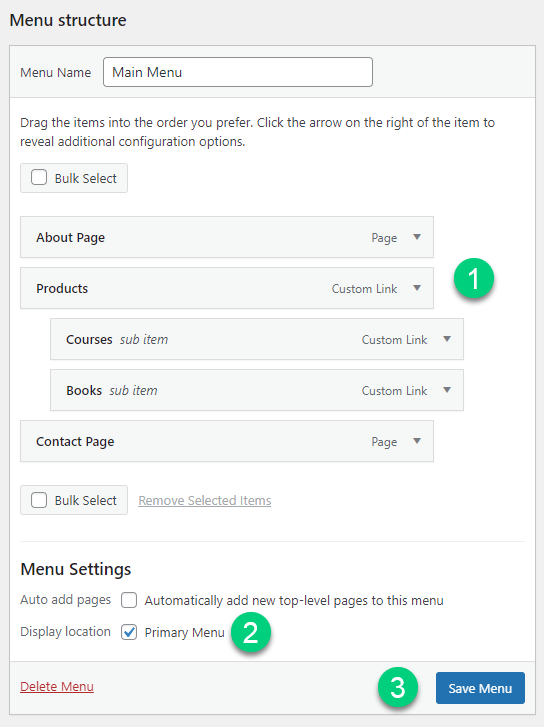
Create Widgets
If you have a sidebar, you can add widgets to it. Go to Appearance > Widgets in your WordPress admin dashboard.
Check out the list of the most useful Blog Widgets and how to add them to your blog.

Set Title & Tag Line
The next step is to change your General Settings. Go to Settings > General in the WordPress Admin area.
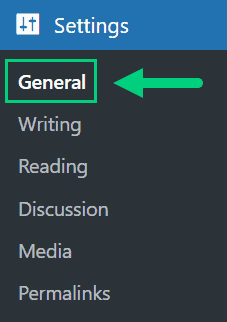
You can set your Site Title, Tagline, and Time Zone from this screen.
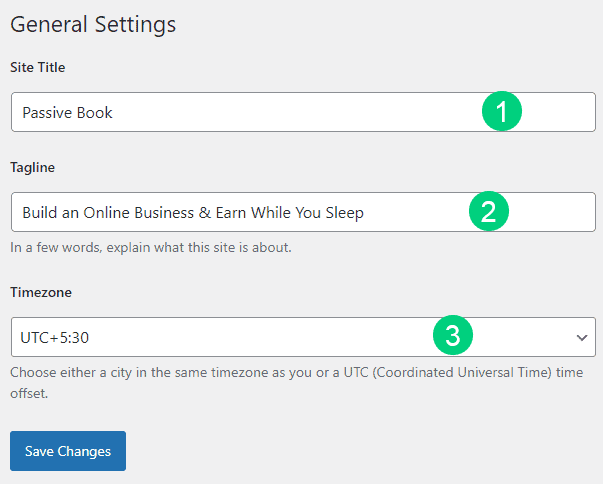
Set Permalinks
The ideal URL structure for SEO is yourdomain.com/sample-post. Set your permalink structure by going to Settings > Permalinks in your WordPress blog dashboard.

Select the “Post name” radio button and save changes.
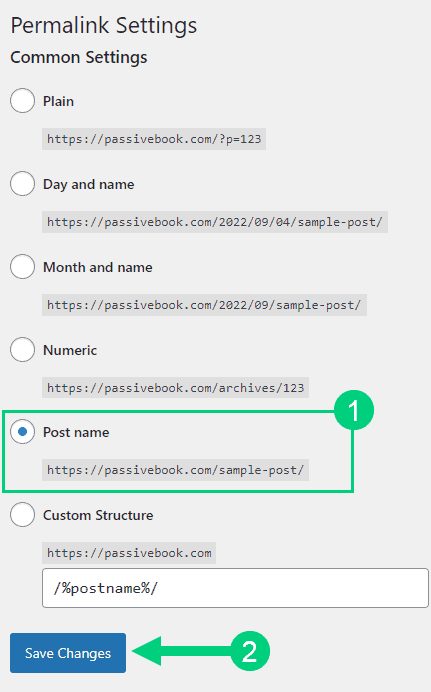
Enable Search Visibility
Chances are you want your blog to show up on Google so people can find you. Go to Settings > Reading in your WordPress dashboard.
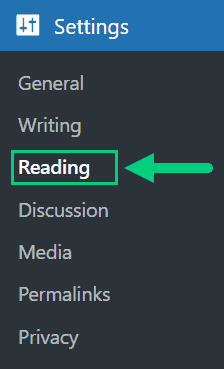
To get search engine traffic, ensure the checkbox “Disable search engines from indexing this site” is Unchecked. You can find this option in Settings > Reading. Most of the time this should be unchecked by default but if it is not, then uncheck it to ensure your site gets traffic from search engines.
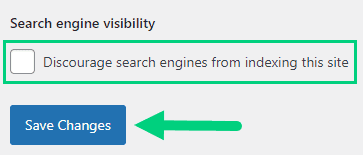
Adjust Comment Settings
Next, you will want to change the Discussion Setting (aka Comments). Go to Settings > Discussion in your WordPress admin area.
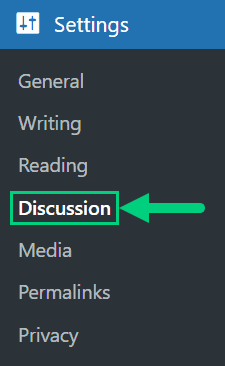
❶ You may want to enable or disable comments on this page. You can also disable pingbacks and enable comment moderation.
❷ You can also set comment approval settings.
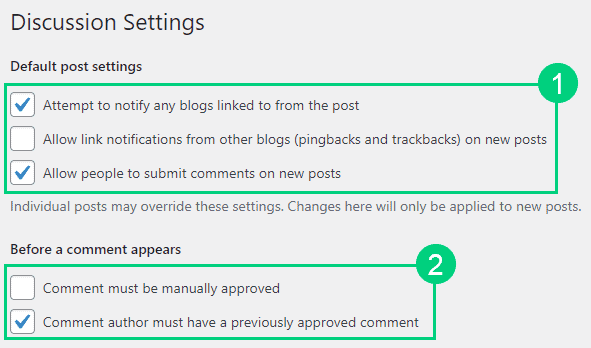
If you want to design your blog further, check out our dedicated guide on blog design which has all our best blog design recommendations.
Create Static Pages
There are a few essential pages that you need to create for your movie blog before you can start blogging.
Use pages in WordPress to add static content. Go to WP Dashboard > Pages > Add New.
- Write the headline of your content.
- Populate the body content
- Click the publish button.
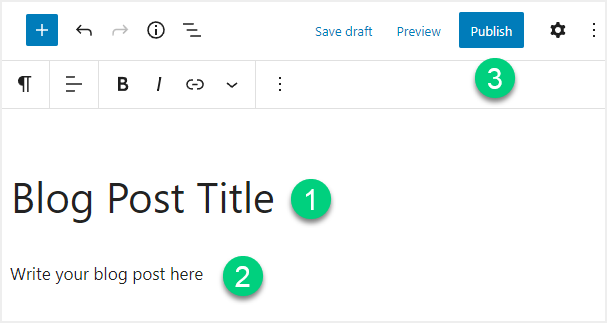
You may want to create the following pages:
Home Page
The home page is the first page that people see when they visit your website. It is usually a page that contains a welcome message, your mission statement, and some of your best content.
You can create a professional home page for your movie blog using a page builder like Thrive Architect.
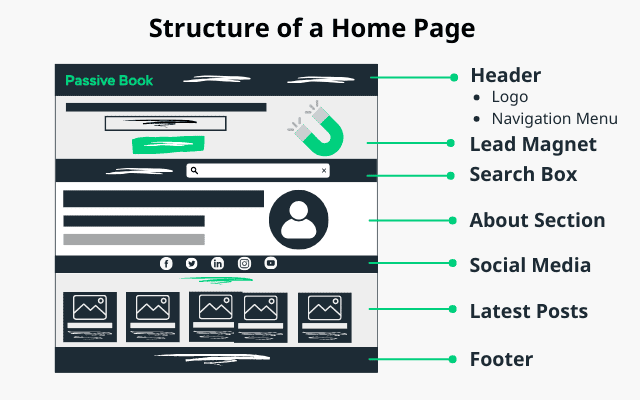
About Page
An about page is a page that tells people who you are and why they should care about your movie blog.
This is important because it allows you to connect with your readers on a personal level and build trust with them.
The About page also allows you to tell people what your movie blog is all about so they can decide if your content is a good fit for them.
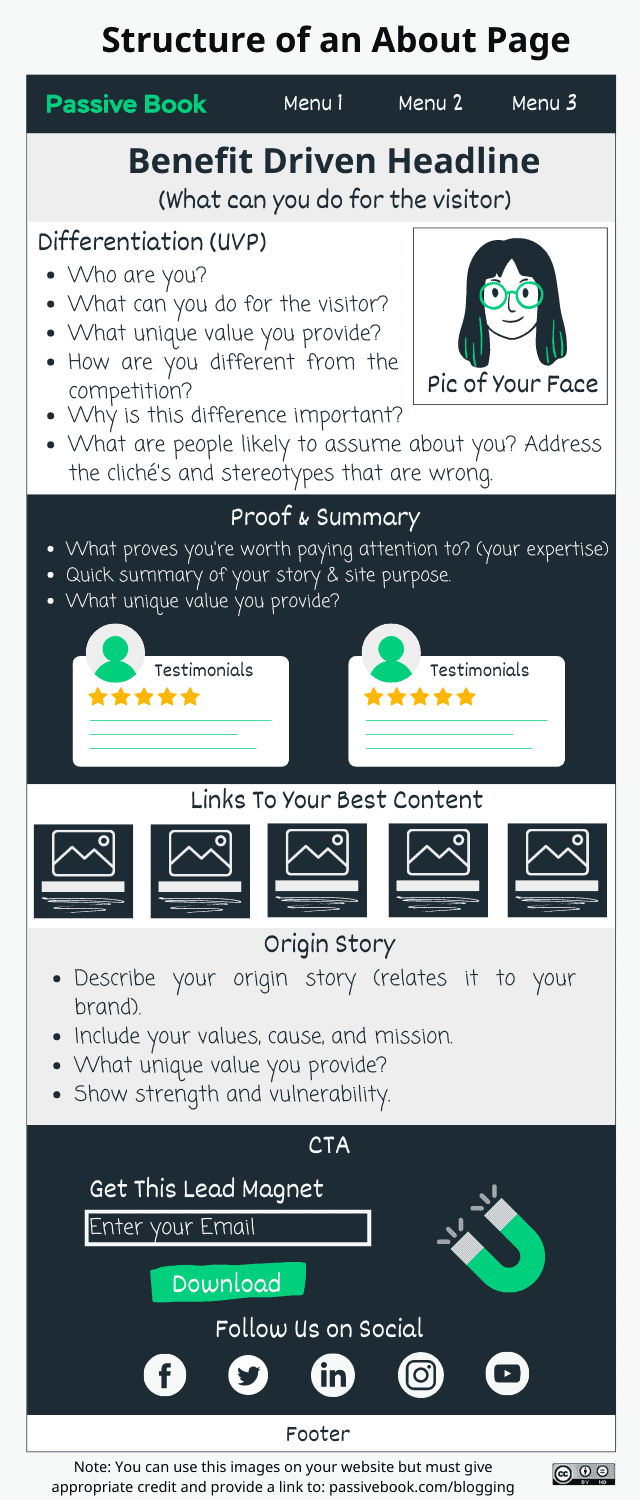
Contact Page
A contact page is a page that allows people to get in touch with you. This page will typically include your contact form, email address, and social media profiles.
This page allows people to easily contact you if they have questions about your movie blog, suggestions for how you can improve your content or partnership opportunities.
Use contact form plugins like Fluent Forms to create the form on your contact page.
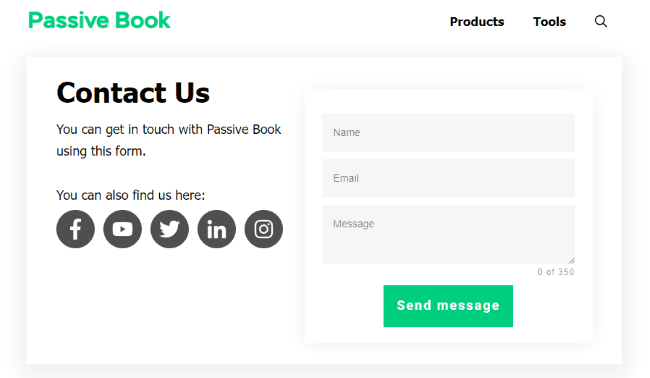
Privacy Policy
A privacy policy page is a page that tells people how you will use their personal data. This page helps you comply with data protection laws such as the GDPR.
You can use a plugin like GDPR Cookie Consent to create a privacy policy page for your movie blog.
WordPress generates its own privacy policy for you. But you can also use a tool like Termly to generate your own privacy policy.
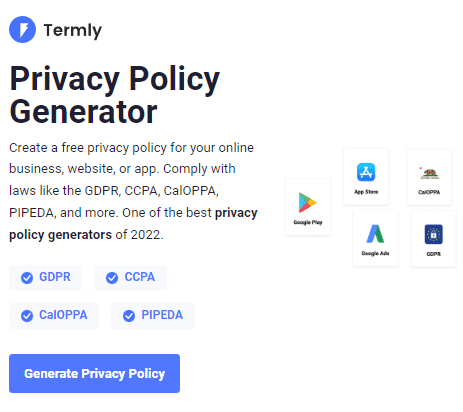
Terms of Service
A terms of service page is a page that sets out the rules for using your website. This page helps you protect your website from people who would misuse it.
Use a terms & conditions generator like Termly to create it.
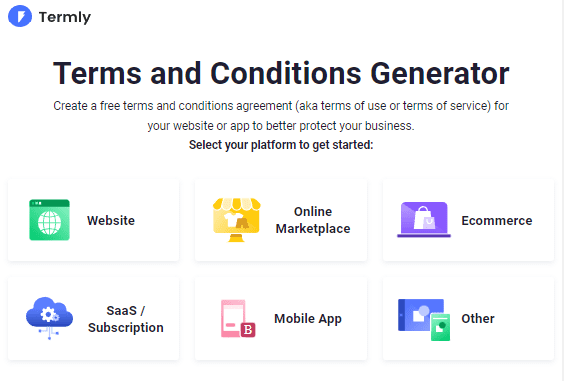
5. Write & Publish Blog Posts
Now that you have your movie blog set up, it’s time to write and publish your first blog post. To craft the perfect blog post, check out our in-depth guide on How to Write A Blog Post. Here we will go over specific tips for a movie blog.
1. Brainstorm Topics
You should brainstorm 100 topic ideas for your movie blog. This will ensure that you always have content to write about in your movie blog.
The goal is to find topics for your movie blog that your audience is searching for on Google. The type of content you write on your movie blog will depend on your specific niche.
Here are a few movie blog post ideas, you can potentially cover in your movie blog:
- Movie Reviews
- Movie Recommendation
- Rumors
There are a few ways to brainstorm specific content:
Look at Competitors
If you want to be a successful movie blogger, you need to be constantly writing new content. But coming up with new ideas can be tough.
One way to come up with new content ideas is to look at what other movie bloggers are writing about. This will give you an idea of the topics that people are interested in and the type of content that is getting the most engagement.
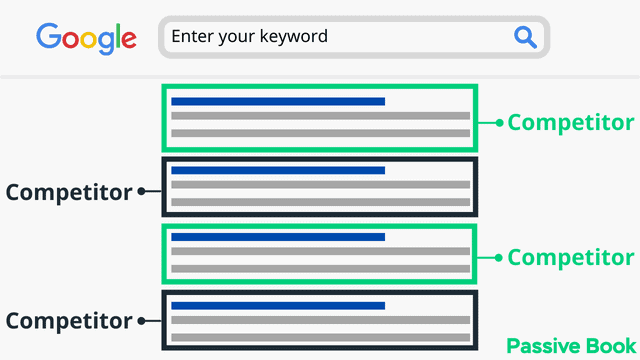
Community & Forums
One way to come up with new content ideas for your movie blog is to look at what people are talking about on communities and forums. This will give you an idea of the topics that people are interested in and the type of content that resonates with your audience.
2. Create an Editorial Calendar
Once you have a list of potential topics for your movie blog, you need to create an editorial calendar. This will allow you to plan how often you publish content and ensure that you are consistently publishing content on your website.
An editorial calendar helps you to:
- Plan how often you will publish content.
- Ensure that you are publishing content consistently.
- Come up with new content ideas.
- Easily see which topics have been covered and which ones have not.
An editorial calendar should include the following information:
- The topic
- The author
- The date the blog post will be published
- The target audience
- The keywords for the blog post
Download Content Calendar Template

Steal our exclusive content calendar template. Have it delivered directly to your inbox:
You can create an editorial calendar in Google Sheets or Trello.
3. Write a Blog Post
Once you have your topic and editorial calendar set up, you are ready to start writing your movie blog post. Check out out guide on how to write a blog post for an in-depth guide. Here we will go over specific tips for a movie blog.
Movie Reviews
A movie review is where you provide your thoughts and opinions on a recently released film. You can provide an evaluation and analysis of the movie, with their opinion on the various elements such as story, acting, cinematography, music, etc. It’s an opportunity for you to share your thoughts on how well you think a film was made and delivered.
Film reviews are usually written by critics or journalists who have experience in the field and can assess films objectively. However, anyone can write a review – all you need is an opinion about what works and what doesn’t work for you! If you’re passionate about movies and want to share your views with other people then writing reviews is a great way to do it.
Some examples of movie review blog post titles include:
- “Review: [Movie Name]”
- “Our Thoughts on [Movie Name]”
- “Is [Movie Name] worth watching?”

Writing movie reviews is a great way to share your opinion on films and express yourself. To do this effectively, you should consider some key elements of writing a review. First, it is important to watch the movie carefully and take notes on what stands out as an element that could either be praised or criticized in the film.
Take notes about scenes that seem important or leave a lasting effect after the credits roll. Also pay attention to details such as acting performances, dialogue delivery, character development, cinematography, and special effects.
Once you have taken some notes while watching the movie, it’s time to write your review. Start by providing an overview of the plot without giving away too much detail so readers can understand where the story is going without spoiling any major plot twists for them.
Next, provide your opinion on the film. Use your notes to back up why you liked or disliked certain aspects of the story and what worked well with the movie as a whole. Finally, write about whether you would recommend this movie to others. Add a link to the full review on IMDB or another site if available.
Interviews
Interviews are where you interview industry professionals such as actors, directors, or producers.
Some examples of interview blog post titles include:
- “Interview with [Actor/Director/Producer Name]”
- “Conversation with [Actor/Director/Producer Name] on [Movie Name]”

When conducting an interview, it’s important to prepare a list of thoughtful and well-researched questions in advance. Try to ask questions that will elicit interesting and insightful responses, rather than simply asking the interviewee to rehash information that can already be found elsewhere.
Look for these individuals on IMDb and Wikipedia to get information on their careers and what they have worked on in the past. Additionally, try to create a relaxed and conversational atmosphere during the interview to put the interviewee at ease and encourage them to open up.
List Post
List post is where you make lists of the top films in a particular genre or decade, for example.
Some examples of movie list blog post titles include:
- “Top 50 Action movies of all time”
- “The best 10 movies of the 90s”
- “The 100 most underrated films of the 21st century”
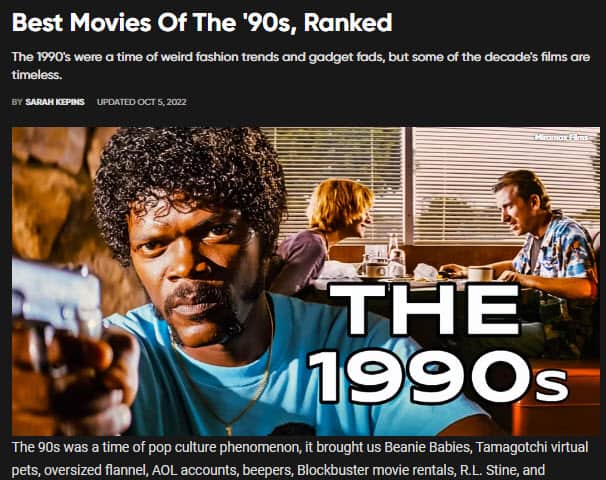
When writing a list post, it’s important to be clear and consistent in your criteria for selecting films. Try to provide specific examples to support your choices, and be prepared to defend your selections in the face of possible criticism. Additionally, consider including a mix of both well-known and lesser-known films to keep the list interesting for both film buffs and casual readers.
News updates
News updates are where you provide your readers with the latest news and information about upcoming films and industry events.
Some examples of News updates blog post titles include:
- “Upcoming movies in 2025“
- “Film festival winners announced”
- “Hollywood casting news”

When writing a news update, it’s important to be accurate and timely in your reporting. Try to verify your information from multiple sources before publishing, and be prepared to update your post if new information becomes available. Additionally, try to provide context and analysis to help your readers understand the significance of the news you’re reporting.
Opinion pieces
Opinion pieces are where you express your thoughts and opinions on industry-related issues, such as the representation of diversity in Hollywood.
Some examples of Opinion piece blog post titles include:
- “Why Hollywood needs more diversity”
- “The Representation of Women in Hollywood”
- “The importance of inclusivity in movie-making”

When writing an opinion piece, it’s important to be clear and persuasive in your argument. Try to provide specific examples to support your points, and be prepared to engage with counterarguments. Additionally, consider including a call to action or a suggestion for how readers can get involved in the issue you’re discussing.
Movie Recommendation
Another type of content that is popular in movie blogs is movie recommendations.
A movie recommendation is an article that gives you a list of movies to watch. It can be organized by theme, genre, or simply a list of good movies.
When writing a movie recommendation, you should:
- Choose a theme or genre for your list
- Include information about each movie on the list
- Add a link to each movie on IMDB or another site if available

Write 5x Faster With AI
You can write your new blog post at 5x speed using the AI writing software Jasper. I was able to write over a hundred blog articles in 3 months using Jasper. This blog article you are reading right now was written with the help of Jasper. AI will not only help you write blog posts fast but also with higher quality.
Jasper can write plagiarism-free blog content, articles, social media content, emails, and ad copy. All you have to do is provide a few inputs on what you want and Jasper will do all the hard work of creating the blog content for you. No more writer’s block.
Check out the video below to see Jasper in action:
Try Jasper for free using the links on this page and get 10,000 bonus credits you can use to start writing your first articles.
Once you sign up for Jasper I recommend you spend some time going through the tutorial videos in the Jasper Bootcamp to truly unlock the power of this amazing software.
Check out our guide on How to Write a Blog Post Fast in 15 mins Without Losing Quality for more tips to write fast.
Outsource Writing
If you find that writing blog posts is too time-consuming or difficult, you can consider outsourcing the work to a freelancer.
There are many online platforms where you can hire writers to create content for your movie blog. Some of these platforms include Upwork, Fiverr, and Writer.

When outsourcing your writing, be sure to:
- Give clear instructions on what you want the writer to cover.
- Set a deadline for when you need the article.
- Choose a writer that has experience writing about movies.
4. Add Images
Images and videos are an important part of any movie blog, as they help to make your content more engaging and visually appealing.
There are many different types of images and videos that you can add to your blog posts, including:
- Screenshots or photos from the movie
- Photos of the actors and directors from the movie
- Movie posters
- Trailers or clips from the movie
- GIFs
When choosing images and videos for your blog posts, be sure to:
- Choose images that are high-quality and visually appealing.
- Use images that are relevant to the content of your blog post.
- Add captions to your images to explain what they are and how they relate to your blog post.
If you can’t take your own pictures, you can use stock photos. There are both free and paid options:
Free Options: Pixabay, Pexels, Upsplash
Paid Options: Deposit Photos, Shutterstock, iStock, Getty Images, 123rf.
You can edit your images in Canva. If you get Canva Pro then you will have access to even more editing features and a large library of stock images.

6. Promote Your Movie Blog
Once you have published your movie blog, you need to start promoting it to movie fans to get traffic to your blog.
There are many different ways that you can promote your blog:
Search Engine Optimization (SEO)
SEO, or search engine optimization, is the process of improving the ranking of your website on search engines.
When people search for a movie online, they may use keywords that are related to your blog post. If your website appears at the top of the search results, you will get more traffic to your website.
To improve your SEO, you should use keywords that your prospective visitor is searching for in the title, header tags, and body of your blog post.
Many factors go into SEO, and it can be a bit confusing to figure out where to start. You can master the more advanced SEO tactics by checking out our SEO Resources.
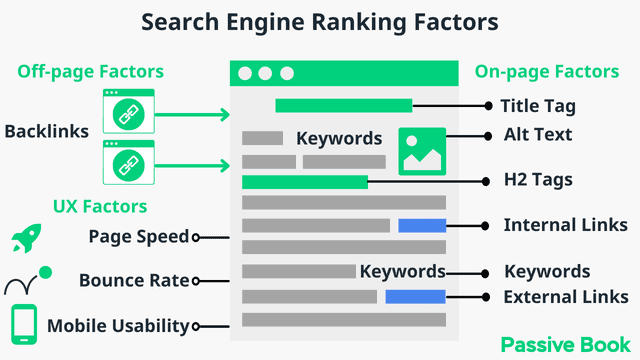
You can ensure you get the basics of SEO right, by completing the recommendations given by the RankMath plugin.
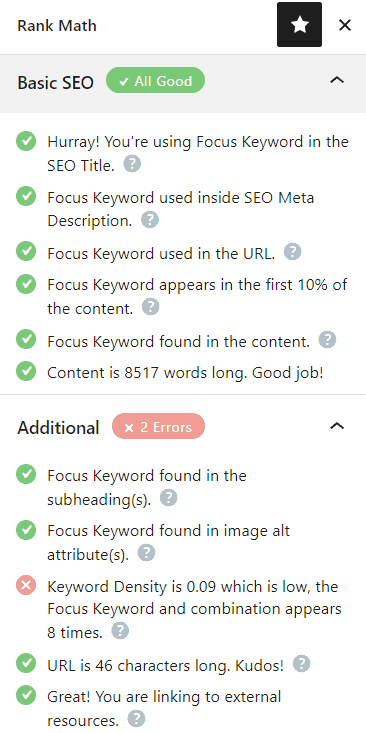
Email Marketing
Another way to promote your movie blog is through email marketing.
Email marketing is the process of sending emails to potential or current customers.
You can use email marketing to:
- Send an email blast to your list of subscribers when you publish a new blog post.
- Notify your subscribers about special events, such as movie premieres or film festivals.
- Provide exclusive content, such as previews of upcoming movies, to your email list.

You can use the Thrive Leads plugin to build opt-in forms to collect email addresses. You can then connect the opt-in form to an email marketing service like Active Campaign to send out the emails.
Check out our Email Marketing resources to learn more.
Social Media Marketing
Social media marketing is the process of promoting your movie blog on social media.
When promoting your blog on social media, you should:
- Post links to your blog content on social media sites like Facebook, Twitter, and Instagram.
- Use relevant hashtags to help people find your content.
- Engage with people who are commenting on your posts or sharing your content.
There are many different social media platforms that you can use to promote your blog, including Facebook, Twitter, Instagram, Pinterest, and LinkedIn.
Guest blogging
Another great way to promote your blog is by guest blogging on other websites.
By guest blogging, you can reach a new audience, get more traffic back to your website, and build credibility and authority in your niche.
To get started with guest blogging, you can search for blogs that accept guest posts by using Google.
Just enter a search term into Google, such as “movie blog + guest post” or “submit guest post + movie blog”.
You can then contact the website owners and pitch them an article idea.
You can link back to your blog from the guest post and also from the author bio.
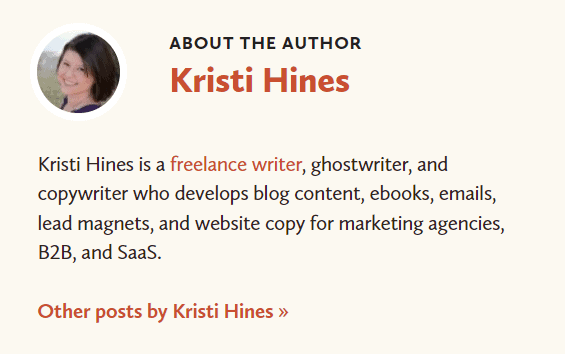
7. Monetize & Make Money
Once you have a successful movie blog, there are many different ways to monetize your website and make money online.
Advertising
One way to make money with your movie blog is by selling advertising space.
You can sell banner ads on your website, or use an ad network to display relevant ads that match the content of your blog post.
To start advertising on your blog, you can sign up for an ad network like Ezoic (they pay more than Google Adsense). When your blog starts getting more than 100,000 page views a month you can monetize with Adthrive.
| Ad Network | Earnings Per 1K Impressions (EPM) | Monthly Traffic Requirement |
|---|---|---|
| Ad Thrive | $13 | 100,000 |
| Ezoic | $3 | 10,000 |
| Media.net | $1 | – |
| Google Adsense | $1 | – |
Affiliate Marketing
Another popular way to monetize your movie blog is through affiliate marketing.
Affiliate marketing is a type of performance-based advertising, where you make a commission for promoting or selling products on behalf of another company. You get paid only when you make the sale with your affiliate link.
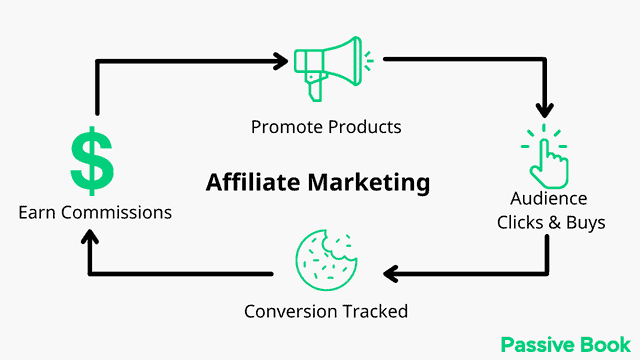
There are many different affiliate networks and programs that you can sign up for, such as an Amazon Affiliate using the Amazon Associates program.
You can then link to movie merchandise or DVDs of the movies you are talking about on Amazon and earn a commission. You can also promote Amazon Prime Video, Apple TV+, Disney+, Hulu, HBO Max, and other streaming platforms and earn a commission for every person who joins.
Digital Products
Another way to make money with your blog is by selling digital products.
You can create and sell eBooks, online courses, or webinars on topics related to movies.
For example, you could create an eBook about how to start a short film or a course about how to become a movie critic.
The sky is the limit when it comes to digital products, so get creative and see what you can come up with.
You can use Teachable if you want to sell video courses. Your students will have a dedicated course members area and a community system to ask questions and interact with each other. If you only want to sell eBooks, you can use SendOwl which lets you sell your digital products and eBooks for free.
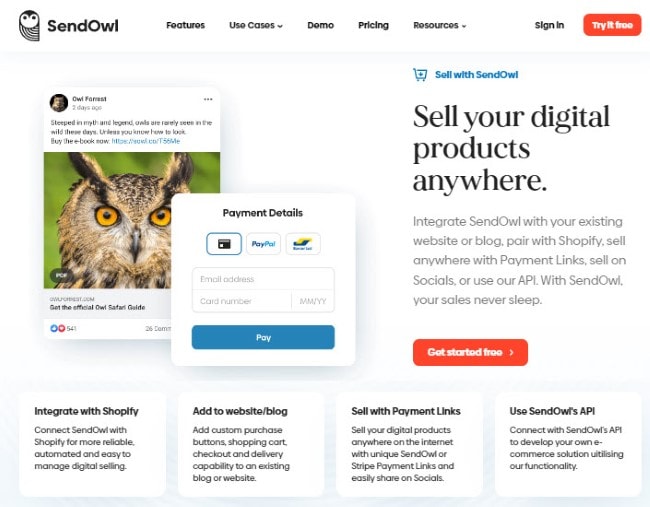
Physical Products
In addition to digital products, you can also sell physical products on your blog.
This could include movie memorabilia, such as posters, DVDs, or Blu-rays.
You could also sell print-on-demand products such as T-Shirts, Mugs, and Posters.
Print-on-demand is a type of manufacturing where products are only printed when an order is placed. This means that you don’t have to keep a large inventory of products, and you can print just one or two items at a time.
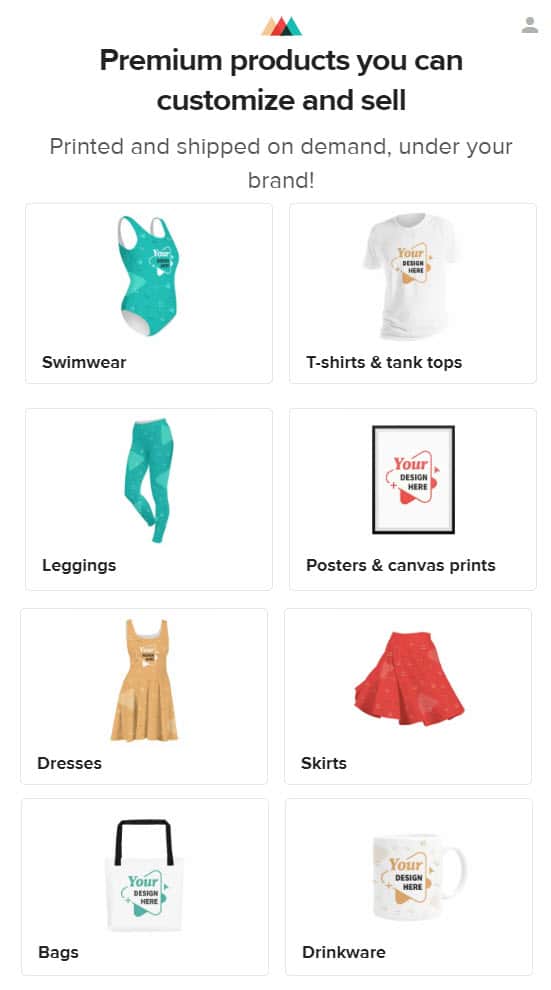
This is a great option for selling physical products on your movie blog, as you don’t need to worry about storing and shipping large quantities of products.
You can get started with print on demand by signing up for Printful.
Just make sure that the products you sell don’t violate any trademarks.
Sponsored Posts
Finally, another way that you can make money with your movie blog is by doing sponsored posts.
Sponsored posts are essentially paid movie reviews, where you are compensated to write a review or share a product on your blog.
The compensation need not always be monetary. You can get free movie tickets or an invitation to a movie premiere. If your blog grows in size PR agencies will pay you to write reviews.
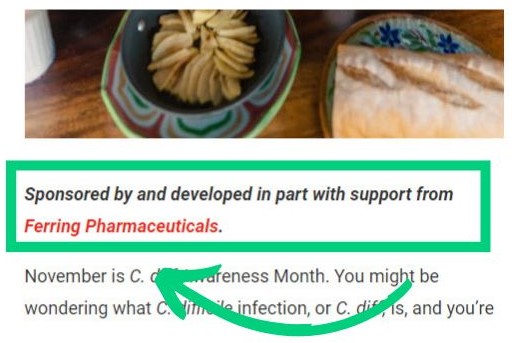
FAQ
Here are a few frequently asked questions:
Can I make a blog about movies?
Yes, you can make a blog about movies. Not only is it a great way to share your passion for movies with the world but it is also a great way to make money online.
What are some ideas for a movie blog?
Some ideas for a movie blog include: reviewing new releases, interviewing movie stars, sharing news about upcoming movies, providing information about how to start a new movie blog, or selling physical or digital products related to movies.
How do you get paid for reviewing movies?
There are several different ways to get paid for reviewing movies, including selling advertising space on your blog, doing sponsored posts, promoting affiliate products related to movies, or selling digital or physical products. You can also use your expertise as a movie reviewer to work with PR agencies and earn money that way.
What Next?
Starting a movie blog is the perfect way for movie buffs to share their passion for movies with the world and monetize their passion.
We hope this guide showed you how to start a movie blog and make money online.
If you have any questions as you set up your new blog, leave a comment below so we can help you out.
Have you started your movie blog yet? What type of movie blog are you going to start? Let us know in the comments.
Share this post with your friends & followers:
